|
Edouard Vuillard.org, welcome & enjoy!

|
|
Here are all the paintings of Alfred R. Waud 01
| ID |
Painting |
Oil Pantings, Sorted from A to Z |
Painting Description |
| 49248 |
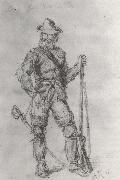 |
A Guerilla |
mk195
ca.1863
Drawing
|
| 49310 |
 |
Battle of Chickamauga |
mk195
1863
Drawing,Library of Congress
|
| 49356 |
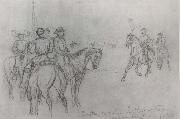 |
General George Custer Receives a Flag of Truce at Appomattox Court House |
mk195
April
1865
Pencil
|
| 49355 |
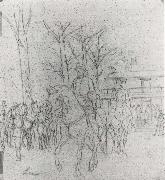 |
General Lee Leaving Appomattox,April 9.1865 |
mk195
1865
Pencil
9x8
|
| 49309 |
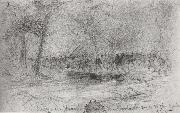 |
Sumner Crossing Chichahominey,Battle of Seven Pines May 31 |
mk195
1862
Pencil,Library of Congress
|
| 49294 |
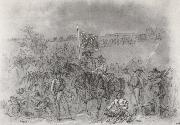 |
The 1st Virginia Cavalry |
mk195
September 1862
Pencil and Chinese white on paper
8x12
|
|
|
| Alfred R. Waud
|
| American, 1828-1891,was an American artist and illustrator, born in London, England. He is most notable for the sketches he made as an artist correspondent during the American Civil War. Before emigration, Alfred Waud had entered the Government School of Design at Somerset House, London, with the intention of becoming a marine painter. This did not come to fruition, but as a student, he also worked as a painter of theatrical scenery. He intended to pursue that work in the United States, when he immigrated in 1850, seeking employment with actor and playwright John Brougham. In the 1850s, he worked variously as an illustrator for a Boston periodical, the Carpet-Bag, and provided illustrations for books such as Hunter's Panoramic Guide from Niagara to Quebec (1857). The period during the American Civil War was time when all images in a publication had to be hand drawn and engraved by skilled artist. Photography existed but there was no way to transfer a photograph to a printing plate since this was well before the advent of the halftone process for printing photographs. Photographic equipment was too cumbersome and exposure times were to slow to be used on the battlefield. An artist such as Waud would do detailed sketches in the field, which were then rushed by courier back to the main office of the newspaper they were working for. There a staff of engravers would use the to sketches create finished engravings for publication. In 1860 Alfred Waud became an illustrator or special artist (a full time paid staff artist) for the New York Illustrated News. In April 1861, the newspaper assigned Waud to cover the Army of the Potomac, Virginia main Union army. He first illustrated General Winfield Scott in Washington, D.C., and then entered the field to render the First Battle of Bull Run in July. Waud followed a Union expedition to Cape Hatteras, North Carolina the next month. That autumn, he sketched army activity in the Tidewater region of Virginia. Waud joined Harper's Weekly toward the end of 1861, continuing to cover the war. In 1864 Alfred brother, William Waud (who up to that time had been working with Frank Leslie Illustrated Newspaper), joined Alfred on the staff of Harper's and they worked together during the Petersburg Campaign. Alfred Waud attended every battle of the Army of the Potomac between the First Battle of Bull Run in 1861 and the Siege of Petersburg in 1865. Alfred was one of only two artists present at the Battle of Gettysburg. His depiction of Pickett Charge is thought to be the only visual account by an eyewitness. Waud died in 1891 in Marietta, Georgia, while touring battlefields of the South.
|
|
 All the Edouard Vuillard's Oil Paintings
All the Edouard Vuillard's Oil Paintings

Supported by oil paintings and picture frames

Copyright Reserved
|

